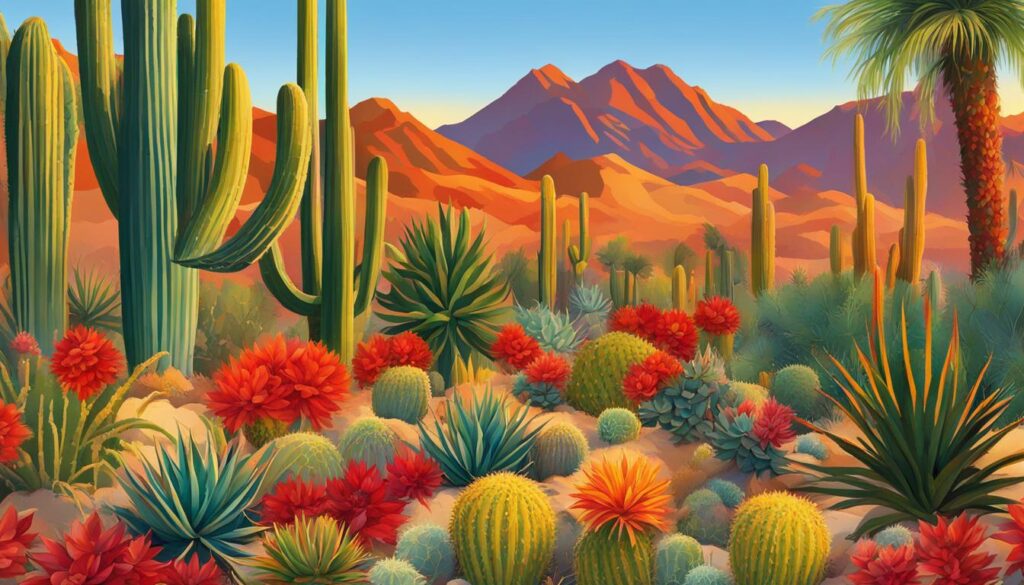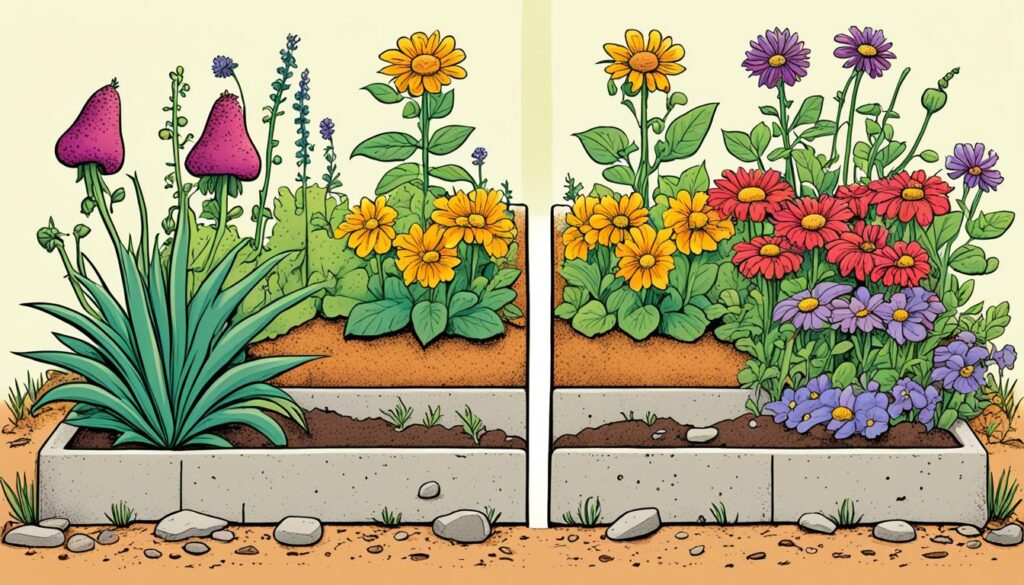Are you ready to transform your desert landscape into a vibrant oasis? Have you ever wondered which plants can thrive in the scorching heat of Phoenix, Arizona? Discover the secrets of gardening in this unique planting zone and unlock the potential to grow a flourishing garden in the desert.
Phoenix, Arizona is located in the Sonoran desert, known for its hot and dry climate. But did you know that despite the challenging conditions, it is still possible to create a stunning garden filled with lush greenery and colorful blooms? Let’s dive into the details of the Phoenix Arizona planting zone to unveil the possibilities awaiting you.
Key Takeaways:
- Phoenix, Arizona falls under USDA zone 9b, which indicates its planting suitability.
- Gardening zones, such as the USDA plant hardiness zone map, Sunset Climate Zone, and Plant Heat Zone, help determine suitable plants.
- Native plants like the Saguaro cactus and Ocotillo are well-adapted to the harsh desert conditions.
- Proper care techniques like drip irrigation and raised beds enhance plant survival.
- Adapting to changing climates requires selecting climate-resilient plants and adjusting gardening practices.
Understanding Gardening Zones
Gardening zones play a crucial role in helping you choose the right plants for your specific region. By considering factors like winter temperatures, geographical location, elevation, frost dates, and humidity levels, you can create a thriving garden tailored to your climate. Three main gardening zone maps provide valuable insights: the USDA plant hardiness zone map, the Sunset Climate Zone, and the Plant Heat Zone.
The USDA plant hardiness zone map focuses on winter temperatures to determine a plant’s cold tolerance. It divides the United States into various zones based on the average lowest temperature. In Phoenix, Arizona, the USDA gardening zone is classified as 9b.
The Sunset Climate Zone takes a more comprehensive approach by factoring in geolocation, elevation, frost dates, and humidity levels. This map provides valuable information on where specific plants will thrive within each zone. In Phoenix, Arizona, the Sunset gardening zone is zone 13.
The Plant Heat Zone map, developed by the American Horticultural Society, assesses a plant’s heat tolerance based on the average number of days with temperatures over 86 degrees. In Phoenix, Arizona, the Plant Heat Zone is 11, indicating the level of heat plants can endure.
To help visualize these gardening zones, refer to the provided table:
| Zone | USDA Plant Hardiness Zone | Sunset Climate Zone | Plant Heat Zone |
|---|---|---|---|
| Phoenix, Arizona | 9b | 13 | 11 |
Understanding these gardening zones will guide you in selecting the most suitable plants for your region. Let’s explore the best plants for Phoenix, Arizona, in the next section.
CLICK HERE TO CHECK OUR RECOMMENDED PRODUCTSBest Plants for Phoenix, Arizona
Growing plants in Phoenix, Arizona can be challenging due to the hot desert climate and limited water availability. However, with the right selection of plants and proper care, you can create a beautiful garden that thrives in this unique environment. Whether you’re looking for native plants that are well-adapted to the harsh conditions or landscaping plants to enhance the beauty of your garden, there are plenty of options to choose from.
Native Plants
Native plants are a great choice for Phoenix, as they are naturally suited to the local climate and require less maintenance. Here are some native plant varieties that thrive in the desert:
- Saguaro Cactus: A symbol of the Southwest, the majestic Saguaro cactus can grow up to 40 feet tall and provides food and shelter for local wildlife.
- Ocotillo: With its unique towering branches and vibrant orange-red flowers, the Ocotillo adds beauty and visual interest to any desert landscape.
- Red Yucca: Known for its striking red flowers and slender leaves, the Red Yucca is drought-tolerant and attracts hummingbirds and butterflies.
- Desert Fairy Duster: This desert shrub produces vibrant pink flowers that attract pollinators and add a pop of color to your garden.
Landscaping Plants
In addition to native plants, there are several landscaping plants that can thrive in Phoenix’s desert climate. These plants are known for their hardiness and ability to withstand the hot and dry conditions:
- Snake Plant: Also known as Mother-in-law’s Tongue, the Snake Plant is a popular choice for its ability to tolerate low light and water conditions, making it a great addition to any desert garden.
- Jack Spratt New Zealand Flax: This decorative grass-like plant features upright, sword-like leaves in a variety of colors and adds architectural interest to your garden.
- Cordyline Australis Red Sensation: With its striking burgundy-red leaves, the Cordyline Australis Red Sensation adds a touch of drama and color to your landscaping.
- Dwarf Schefflera Umbrella Tree: This compact evergreen shrub features glossy, palmate leaves and is perfect for adding greenery and a tropical touch to your outdoor space.
- Croton Petra: Known for its vibrant and colorful foliage, the Croton Petra adds a tropical and exotic feel to your garden.
When choosing plants for your Phoenix garden, it’s important to research their specific needs, including sunlight requirements, water needs, and soil preferences. Consider using drip irrigation systems to conserve water and provide targeted hydration to your plants. Raised beds can also help improve drainage and prevent waterlogged soil. Additionally, be mindful of the best planting times according to the local climate to ensure the success of your garden.

Creating a flourishing garden in Phoenix, Arizona is possible with the right selection of plants and gardening practices. By choosing native and landscaping plants that are well-suited to the desert climate, implementing efficient irrigation systems, and being aware of the best planting times, you can create a beautiful oasis in the midst of the desert. So roll up your sleeves, put on your gardening gloves, and let your garden thrive in the arid landscape of Phoenix, Arizona!
Phoenix Gardening Tips
Successfully gardening in Phoenix requires attention to specific tips and techniques. Due to the dry spells and high temperatures, it is important to keep the soil moist through methods like drip irrigation systems. Mulching can also help retain moisture in the soil and prevent rapid evaporation. Raised beds are a useful solution for plants that may suffer in the hot and dry soil, providing better control over temperature and moisture levels.
Additionally, considering the best planting times according to the local climate and protecting plants from extreme heat are essential. Local resources and weather observation can help determine the ideal timing for planting and harvesting in Phoenix.
Soil Moisture
Ensuring proper soil moisture is crucial for successful gardening in the arid climate of Phoenix. The desert soil can quickly dry out, depriving plants of the necessary hydration. To maintain adequate moisture levels:
- Use a drip irrigation system to deliver water directly to the base of plants, minimizing evaporation and maximizing absorption.
- Regularly check the soil moisture by inserting a finger into the ground. If it feels dry at a depth of 2-3 inches, it’s time to water.
- Water deeply and less frequently to encourage plants to develop deep root systems, enabling them to access water from lower soil layers.
Mulch
Mulching is an effective technique to conserve soil moisture and regulate soil temperature. Here’s how mulching can benefit your Phoenix garden:
- Apply a layer of organic mulch, such as wood chips or straw, around plants to suppress weed growth and reduce evaporation.
- Mulch also insulates the soil, protecting the roots from extreme heat and cold.
- Ensure the mulch layer is about 2-3 inches thick, avoiding direct contact with the plant stems to prevent rot.
Raised Beds
Raised beds offer numerous advantages in the desert climate of Phoenix. They provide better control over soil conditions and can enhance plant growth and productivity. Consider the following benefits of raised beds:
- Improved drainage: Raised beds allow water to drain more effectively, preventing waterlogging and root rot.
- Better soil quality: Amending the soil in raised beds with compost and organic matter ensures a nutrient-rich environment for plants.
- Temperature regulation: Elevated beds warm up faster in the spring and retain heat for longer during cooler nights.
Planting Times
Choosing the right planting times is vital to maximize the success of your Phoenix garden. The hot desert climate requires careful consideration of the seasons and temperatures. Here are some guidelines for planting in Phoenix:
- Avoid planting during the scorching summer months when temperatures are excessively high. Instead, focus on early spring and late fall for most crops.
- Consult local gardening resources or extension offices for planting calendars specific to the Phoenix area.
- Consider the heat tolerance of plants when selecting varieties for your garden.
| Common gardening tips | Phoenix-specific tips |
|---|---|
| Water plants deeply, rather than frequently, to encourage deep root growth. | Use a drip irrigation system to deliver water directly to plant roots and minimize evaporation. |
| Apply a layer of organic mulch around plants to conserve soil moisture. | Choose mulch made from local materials to enhance water retention in the desert climate. |
| Incorporate compost into the soil to improve fertility and drainage. | Consider raised beds to optimize soil conditions and regulate temperature and moisture levels. |
| Plant in the spring or fall for most crops. | Consult local planting calendars to determine the best planting times for Phoenix. |
Changes in Plant Hardiness Zones
The impact of climate change has led to significant changes in plant hardiness zones across the United States. These changes reflect the shifting weather patterns and temperatures that affect the suitability of different plant species for specific regions. The USDA’s plant hardiness zone map is a valuable tool that provides guidance to growers and gardeners, helping them adapt to these changing climatic conditions and select plants that are most likely to thrive in their area.
While some regions in the country have experienced substantial shifts in their plant hardiness zones, the changes in Arizona and the Southwest have been relatively minor. Most of the Phoenix area, for example, remains in zones 9b and 10a, with average annual extreme minimum temperatures ranging from 25 to 35 degrees Fahrenheit. These zones indicate the cold tolerance of plants and help gardeners determine which species are best suited for their gardens.
By understanding the changes in plant hardiness zones and the impact of climate change, gardeners can make informed choices about the plants they grow. It is crucial to select species that can withstand the specific temperature and weather conditions of their region. Adapting to these changes ensures the long-term success and resilience of gardens in the face of a changing climate.

Adapting to a Changing Climate
As the climate continues to shift, it is essential to adapt gardening practices to promote the survival and health of plants. Here are some strategies to consider:
- Choose Climate-Resilient Plants: Select plant species that are known to be more resilient to heat, drought, and changing weather patterns. Look for varieties that have adapted to your specific climate and are more likely to thrive in the new conditions.
- Implement Proper Watering Techniques: With changes in rainfall patterns, it’s important to adjust watering practices accordingly. Utilize efficient irrigation systems such as drip irrigation to deliver water directly to the roots, minimizing water loss through evaporation.
- Utilize Mulch: Applying a layer of mulch around plants helps conserve moisture, regulate soil temperature, and suppress weed growth. Organic mulches such as wood chips or straw can also improve soil quality over time.
- Monitor and Adapt: Regularly observe and assess your garden’s performance. Pay attention to how plants respond to changing conditions and make necessary adjustments to optimize their growth and resilience.
By embracing these strategies and staying informed about changes in plant hardiness zones, gardeners can navigate the impacts of climate change and continue to enjoy productive and beautiful gardens.
Adapting to Climate Shifts
Climate shifts have significant implications for plant selection and gardening practices. As temperatures change, it becomes crucial to choose plants that are well-adapted to the current and projected climate of your region. This includes considering the lowest likely winter temperature and the ability of plants to withstand heat and drought.
While some plants may benefit from warmer winter temperatures, it’s important to be aware of the potential downsides, such as increased pest populations that can negatively impact your garden. Additionally, hotter and drier summers pose challenges for plant survival, making it essential to select climate-resilient plants that can thrive under these conditions.
To adapt to climate shifts and ensure the success of your garden, consider the following strategies:
- Choose climate-resilient plants: Opt for plant varieties that are known to tolerate extreme temperatures, drought, and other environmental stresses. Native plant species are often well-adapted to local climate conditions and can provide excellent options for your garden.
- Implement proper watering techniques: Efficient irrigation methods, such as drip irrigation systems, can help conserve water and ensure that your plants receive adequate hydration without wastage. Mulching can also help retain moisture in the soil and reduce evaporation.
- Adopt sustainable gardening practices: Implementing practices like composting, using organic fertilizers, and practicing integrated pest management can enhance the resilience of your garden and reduce the environmental impact of gardening.
- Monitor and adjust planting schedules: Stay informed about the changing climate patterns in your region and adjust your planting schedules accordingly. Understanding the optimum planting times for different crops and plants can significantly improve their chance of survival and success.
By adapting to climate shifts and choosing climate-resilient plants, you can create a garden that not only withstands the challenges of changing weather patterns but also thrives in the face of adversity.
Testimonials
“Since I started choosing climate-resilient plants and implementing sustainable gardening practices, my garden has become more resilient to extreme weather conditions. I no longer have to worry about the unpredictability of the climate, and my plants thrive year-round.” – Jane Smith, Phoenix, Arizona
Keep in mind that adapting to climate shifts requires ongoing attention and flexibility. Stay informed about climate trends, experiment with different plant varieties, and continue to refine your gardening practices to ensure the long-term success of your garden.
CLICK HERE TO CHECK OUR RECOMMENDED PRODUCTSConclusion
The planting zone in Phoenix, Arizona is classified as zone 9b according to the USDA plant hardiness zone map. This means that gardening in this desert region comes with its fair share of challenges. However, with the right knowledge and techniques, you can transform the arid landscape into a thriving garden oasis.
Understanding the specific gardening zones in Phoenix is crucial for selecting suitable plants. Native plant varieties such as the Saguaro cactus, Ocotillo, and Desert Fairy Duster are well-adapted to the harsh conditions and provide food and shelter for local wildlife. Utilizing irrigation systems, such as drip irrigation, can help conserve water and ensure your plants receive adequate moisture.
Adjusting your planting times to align with the local climate is also essential. The hot and dry climate of Phoenix means that certain plants may not flourish if planted at the wrong time. By researching the specific needs of each plant and following local gardening advice, you can increase the chances of success.
Gardening in the desert may require some extra effort, but the rewards are worth it. With the right plants and care, you can create a lush and vibrant garden in the heart of Phoenix, Arizona.
FAQ
What is the planting zone for Phoenix, Arizona?
Phoenix, Arizona is classified as zone 9b according to the USDA plant hardiness zone map.
What are gardening zones?
Gardening zones are determined by various maps and charts that help gardeners choose plants suitable for their specific region.
How do gardening zone maps determine plant suitability?
The USDA plant hardiness zone map looks at winter temperatures, the Sunset Climate Zone considers geographical location and humidity levels, and the Plant Heat Zone map uses average days with temperatures over 86 degrees.
What are some recommended plants for Phoenix, Arizona?
Native plants such as the Saguaro cactus, Ocotillo, Red Yucca, and Desert Fairy Duster, as well as landscaping options like the Snake plant and decorative grasses, are recommended for Phoenix. Other options include the Dwarf Schefflera Umbrella Tree and Croton Petra.
What are some gardening tips for Phoenix, Arizona?
It is important to keep the soil moist with drip irrigation systems, use mulch to retain moisture, consider raised beds for better control over temperature and moisture, plant at the appropriate times according to the local climate, and protect plants from extreme heat.
How have plant hardiness zones changed?
The USDA plant hardiness zone map was recently updated to reflect the impact of climate change. While some regions experienced significant changes, the changes in Arizona and the Southwest were relatively minor.
How can gardeners adapt to climate shifts?
By selecting climate-resilient plants and implementing appropriate gardening techniques, gardeners can adapt to climate shifts and continue to grow successful gardens.
